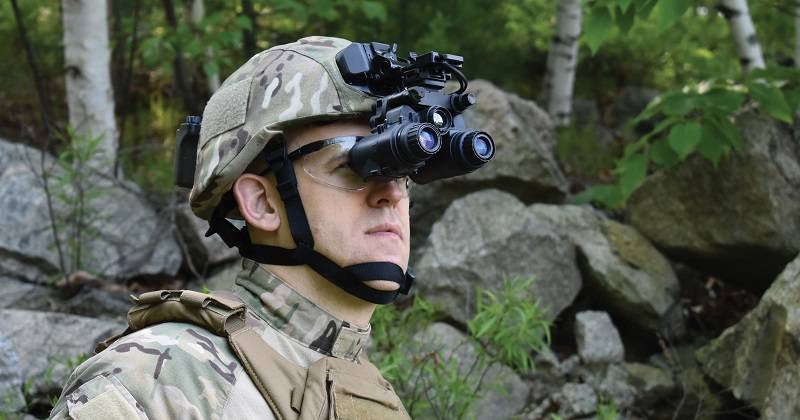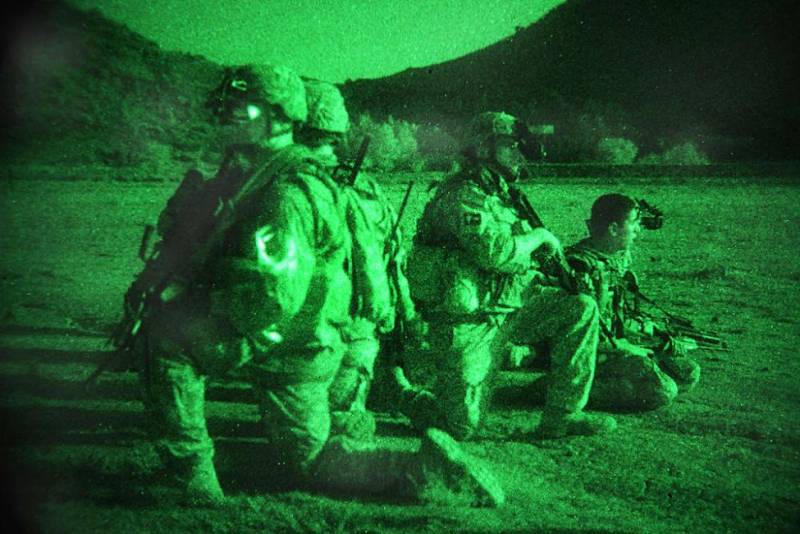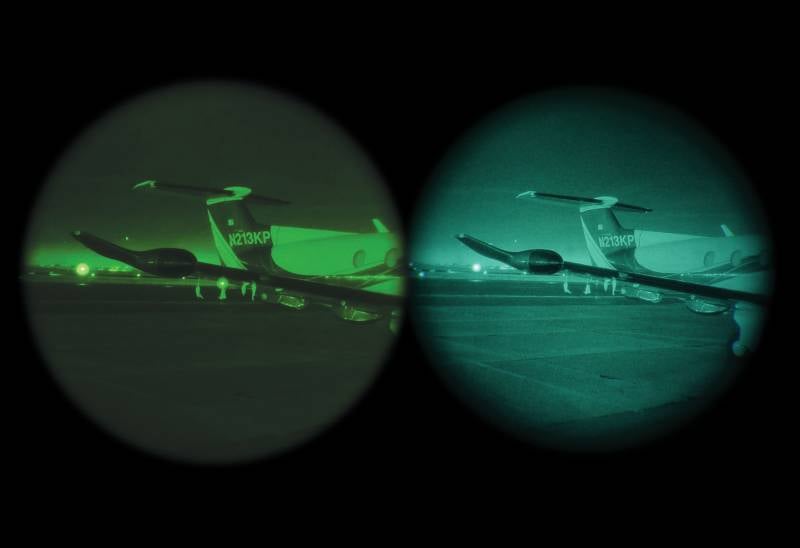Get out of darkness: new trends in night vision
Significant efforts are being made to increase the effectiveness of night-time combat operations by the United States Department of Defense, which is exploring several new concepts that can not only offer new night-vision devices with optimal performance, but also integrate new features into basic models in order to improve their knowledge of the situation. a separate soldier and a small unit.
Take possession at night
According to Daryl Heckler, head of the night vision sector at Harris Corporation Communications Systems, the industry must take into account many of the most important requirements for providing American and other international programs.
A representative of Harris Corporation explained that the market for optical-electronic / infrared (OE / IR) systems today is capable of providing more than just small units. Night vision devices are currently able to increase the level of situational awareness of combat and reconnaissance groups through the integration of augmented reality, virtual reality and machine learning.
Recalling the evolving operational requirements of the armed forces of many countries, Heckler added: “Systems that incorporate sensor integration technology [MA / IC], the ability to send and receive important information through their visual systems (day and night), systems allowing the user to become a sensor, everything this will be paramount in the future. ”
Integrated solutions
Similar needs are being considered by the Special Operations Forces Command and the US Army, which have already begun research on specialized concepts in order to see how these urgent operational needs can be simplified in the short to medium term.
There is a lot of theoretical and practical work in the field of night vision technology. One example is an industrial seminar held last November at the Laboratory of Applied Physics in Baltimore, which focused on integrating displays with augmented and virtual reality with projection displays of night vision HUD (head-up display), as well as software augmented reality in order to "improve the optical characteristics" of existing devices.
This seminar, organized by the Department of Rapid Response Technologies, which is part of the US Department of Defense, looked at developments in the field of merging data from various sensors and their subsequent processing, as well as targeting problems, as the US military leadership develops strategic plans for the widespread introduction of promising technologies and devices to the troops night vision.
At the same time, the US Army is working on its Integrated Visual Augmentation System (IVAS), which surrounds the fighter with digital data on tactical situations in order to provide ground units with "increased lethality, mobility and situational awareness to achieve superiority over current and future opponents."
The IVAS concept, designed to develop the capabilities of existing on-site optical thermal imaging displays, including the PVS-5, -7, -14 and -31, PSQ-40 ENVG III models and the ENVG-B binocular prototype, is also aimed at creating ultra-compact thermal imaging and low illumination modules with standard interfaces. They can be connected to the overall electronic architecture of the soldier and the squad, integrated into projection displays, into the Nett Warrior 3.0 soldier upgrade program, with augmented reality algorithms and software, machine learning interfaces and squad fire performance.
According to the representative of the army, who spoke at this event, these new technologies will be used to ensure "rules-based planning and decision-making, quantitative pattern recognition, change identification and identification."
The representative of the US Army was unable to provide additional details regarding this activity. However. Industry sources associated with this program have confirmed that the Night Vision and Electronic Sensors Directorate (one of the army structures) continues to study "developing and standardizing sensor modules with aggressive sizes, weights and power consumption for head-mounted and wearable options in order to increase the capabilities of the future soldier" .
Development work is expected to include the development of uncooled devices operating in the near [long wavelength] IR region of the spectrum, and combined digital sensors operating in low light and in the far IR region of the spectrum, in order to complement existing OE / IR solutions, as mentioned above. The project will be attended by about 40 players, including BAE Systems. Harris Corporation, L3 Technologies and SA Photonics.
In November, Microsoft Corporation received a contract from the Ministry of Defense worth 479 million dollars in support of the IVAS program. According to an official statement on the Federal Business Opportunities website, the company received a task to deliver hardware, software, and interfaces to support the IVAS program within two years; An initial batch of more than 2500 prototypes for technology demonstration is planned.
Neither the army nor Microsoft was able to reveal the details of the contract, although industry representatives said that the latter plans to integrate its HoloLens projection display into the IVAS concept in order to explore further development paths.
According to Microsoft's documentation, HoloLens technology combines virtual reality and real-world environments into a mixed “combined reality”. Subsystems integrated into this device can be controlled by “voice, physical commands and the direction of gaze”.
As Heckler explained, Harris Corporation, in accordance with its own development plan for night vision devices, continues to explore new technologies for the IVAS system in order to improve support for the next generation fighter. Particular emphasis is placed on “as quickly as possible” the introduction and integration of new technology into existing devices.
“The OE / IR systems with a network interface and / or augmented reality will have a huge impact on customers seeking better situational awareness on the battlefield,” said Heckler.

Fast development
However, given that the initial deliveries of prototypes with IVAS technology and their evaluation by the US Army are not expected in the next at least two years, many manufacturers in the market for OE / IR devices continue to focus on more rapid implementations of existing equipment.
Describing the current state of the market for night vision devices and short-term solutions, Heckler said: “Now is the best time for the global industry for night vision systems. We see high demand in the field of night vision and we are seeing a transition to white phosphor technology in almost all the world. The transition from monocular to binocular systems also seems to be gaining momentum; all our customers want higher performance. We believe that the demand for higher performance systems and the transition to a white phosphor and binocular systems will continue in the next few years. ”
The growing interest in binocular night vision devices with white phosphor confirms the latest requirement of the US Marine Corps, which in November 2018 published a draft request for proposals on its SBNVG (Squad Binocular Night Vision Goggle) night vision device.
According to official documents, also published on the Federal Business Opportunities website, the KMP is looking for a modular binocular device with a white phosphor with enhanced image brightness and with an integrated uncooled thermal imaging sensor, as well as an external power supply to it and a corresponding mount to the helmet.
The requirements provide for a pair of 18-mm electron-optical converters that can be assembled into a modular configuration so that users who prefer to look with one eye, if necessary, can convert the device into a monocular. In addition, the proposed technology should provide, in addition to working from its own battery, a connection via an external connector to the battery pack.
Finally, the total weight of the selected SBNVG device — including sensors, an image converter, a thermal imaging sensor, an external battery pack, cables, lenses, and light boxes — should be less than 1,2 kg. However, the request for proposals stipulates that "the weight of the system does not include mounting brackets attached to the helmet, which has an interface with a positioning device, or any other mounting interface that is permanently attached to the helmet."
The SBNVG requirement is seen as an intermediate opportunity for the USCM, which also plans to receive 2021 ENVG-B night vision goggles from L3100 Technologies by the year 3.
The ENVG-B device has already been selected by US ground forces; from 2019 to 2021, the year will be procured for various army structures over 10000 systems, initially in a monocular version and later in binocular configurations.
In June, 2018, under a three-year contract, the army issued a contract to L3 Technologies company worth 391 a million dollars to supply ENVG-B night vision goggles. "The white phosphor and two-tube solution allow users to keep up with almost equal rivals, increasing maneuverability and improving target designation throughout the battlefield," said the company director.
The ENVG-B device, which is also considered as a possible candidate for the IVAS concept, is able to integrate a separate IR channel, which can be combined with the image brightness enhancement channel to increase the probability of target detection. Additional requirements include the ability to connect to network devices, such as a programmable radio station and end-user smartphone / tablet, included in the upgrade program soldier Nett Warrior.
“This technology improves the operator’s ability to locate and capture threats and evaluate images of the overall operational environment,” said a spokesman for L3 Technologies. “ENVG-B also includes a new high-resolution display and an integrated wireless network, a fast target acquisition function and augmented reality algorithms for interacting with advanced soldier systems while improving interaction and expanding the scope of application.”
In addition, L3 Technologies offers another device in the form of helmet panoramic night vision goggles GPNVG (Ground Panoramic Night Vision Goggle). However, the company confirmed that GPNVG points are not planned to be upgraded as part of the IVAS program.
According to the company, GPNVG provides a field of view across the horizon 97 °, which allows "to observe and / or identify targets in low light conditions when increased strength and impact resistance are needed."
Channel matching
Meanwhile, Harris Corporation offers its i-Aware TM-NVG (Tactical Mobility-Night Vision Goggle) night vision goggles in monocular and binocular configurations. They implemented a combination of images from two channels, low light and infrared.
Thanks to the development of augmented reality technology, the translucent display of the TM-NVG device displays GPS coordinates, topographic elements, text messages and target information. Other capabilities allow the user to view images directly from remote surveillance and information gathering sensors, including images from special reconnaissance aircraft and drones.
The TM-NVG device has a field of view 33 °, a resolution of a long-wave IR sensor 320x240, a video resolution 640x480 up to 10 frames per second. TM-NVG also has a 2.0 USB connector and is powered by four AA batteries, allowing you to work continuously with the device for 7,5 hours.
In October 2018, Harris Corporation and L3 Technologies announced a merger, although company representatives could not say anything about the plans of the new Harris L3 Technologies company to develop night vision devices.
Work at zero visibility
In addition to the United States, there is a growing need for CMOS technology (a complementary metal-oxide-semiconductor structure), which significantly improves the quality of operations in low and zero light conditions. Several companies currently offer ready-made advanced solutions to the armed forces of many countries.
At the Africa Aerospace and Defense exhibition in the South African Republic, held in September 2018, Photonis presented the latest device from its Nocturn family of digital cameras, designed to meet the military’s needs for weapons and weapon sights, which have the function of merging images from two channels .
First introduced to the public at Eurosatory 2018, the EBCMOS device is based on a Photonis Nocturn digital CMOS camera and has a smaller form factor and increased image resolution compared to other night vision devices.
“Most demanding visualization applications in extremely low-light environments require advanced digital solutions,” said a Photonis spokesperson. - EBCMOS is an electron-optical converter, in which microchannel plates and a phosphor screen are replaced by a special CMOS photodetector. The EBCMOS device, currently available with two 2 resolutions and a 4 megapixel, provides users with a higher resolution and a higher contrast image. ”
Another player in the CMOS technology market, Rochester Precision Optics, offers the military its CMOS Night Observation Device CMOS night observation device. The buyers of this device are the American Special Operations Command and the Anti-Drug Administration.
A company spokesman said that CMOS technology provides a more accurate and clear image for users operating in difficult combat conditions, including settlements and close combat.
According to a Rochester Precision Optics representative, the CNOD is available in a variety of configurations, including the RSM model for law enforcement, the LD model for military customers, and the DR model for long distances. "CNOD has a high resolution, fully digital day / night optics, optimized for operation as a monocular observation, a separate weapon sight or a mounted additional sight."
The system, which operates in the 500-1800 nm range, is capable of detecting its own and foreign laser pointers and rangefinders - a function useful and demanded by the armed forces operating in an increasingly dense combat space, where the elimination of conflict situations between the parties remains the primary task.
The CNOD device weighs 520 grams and is powered by CR123 batteries, has a digital magnification 6x, and also has the function of transferring high-resolution photos and videos to other combatants.
Achieving success
Based on CMOS technology, Absolute Darkness to Vision (AD2V) also develops hand-held, helmet-mounted, and mounted on weapon devices and supplies them to the German Ministry of Defense.
Compared to the alternative night vision goggles currently available on the market, the Luxiter PM1 digital night vision system from AD2V is smaller in size. According to Wilhelm Gronauer from Griffity Defense (the European distributor of AD2V), the Luxiter PM1 digital device is capable of “recording and exporting streaming video generated by its own matrix, importing data from external sources, and controlling commands from devices and sending text messages.”
With a mass less than 300 grams, the Luxiter PM1 device has a resolution of 795x596 pixels and a variable field of view varying from 19 ° to 56 °. However, the device was designed for relatively short ranges; Gronauer confirmed that the device provides detection and identification of objects at the maximum range of 100 meters.
In addition, Gronauer explained that the CMOS sensor minimizes any negative optical effects in the operator's field of view during firing in confined spaces, and added that the Luxiter PM1 device is equipped with an infrared illuminator to operate in low light conditions.
The device can also be supplemented with an Luxiter EC-2H external camera so that users can get additional benefits in the form of streaming data through the interface of programmable radio stations.
Small doubts remain that night vision will remain the most important need of the ground forces in current and future operational scenarios. However, the potential of this technology, integrated into various situational awareness systems, can give a significant impetus to the development of the next generation solution.
However, as one industry expert explained, the implementation of this type of technology should be carefully monitored, with particular emphasis on minimizing the cognitive load on operators in the already quite complex operational space.


Information